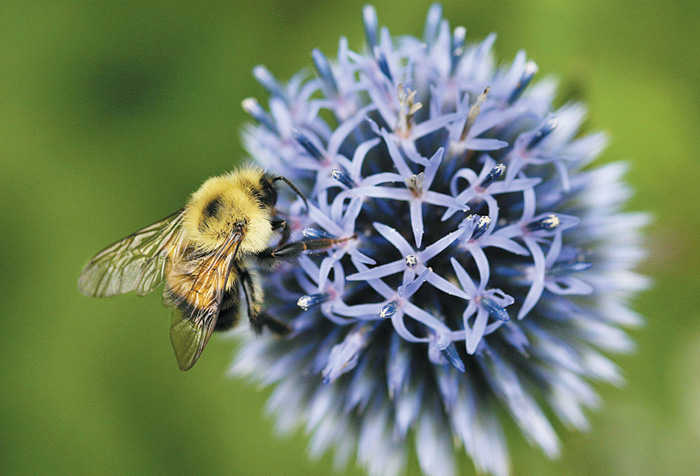Harbingers of Spring


After a long winter, queen bumblebees emerge to lay new colonies
By Sara Scudier
Certified volunteer naturalist
Queens hatch late in the colony cycle and mate in early fall. These are the only bumblebee individuals that survive the winter. They hibernate in the soil in a location that will not warm up too quickly or too early in the spring in order to avoid a potentially lethal early emergence. Once these solitary queens emerge, they begin to look for a suitable nest location and begin vigorously gathering both nectar and pollen.
Normally, this lonely female establishes a nest in an abandoned rodent or bird nest in the ground. The queen begins the colony by collecting pollen and forming it into a small lump. She lays 6-8 worker eggs on this pollen. Once the first brood develops, they take over all the colony duties except egg laying. The adult workers collect pollen and nectar, and feed the larvae. Nectar is collected and stored in small saclike “honey pots” built from wax and pollen. The workers enlarge the nest and by midsummer the colony will have 20-100 workers. Although the workers will defend the colony, bumblebees rarely sting.
Bumblebees are strong flyers and are able to forage up to one mile away from their nests and fly in winds as strong as 9 miles per hour. They generate sufficient metabolic heat to be able to fly efficiently in cool mornings or even in the relatively chilled evenings.
Bumblebees forage in a wide range of flowers. They have excellent color vision, UV spectrum vision and good color/pattern memories. They are attracted to bright white, blue, yellow and ultraviolet colors. You will notice them on many crocus species in your yard. There are a large number of native plants, and some introduced species as well, which have flowers in these colors and will attract these beneficial creatures to your yard.
Many flowers have features that encourage pollination by bumblebees. In addition, bees may develop flower preferences through trial and error during nectar and pollen gathering successes. An individual foraging bee may visit many thousands of flowers in order to gather sufficient nectar and pollen for its colony. Some bees may even “overnight it” in the shelter of the flower petals.
Penn State College of Agricultural Sciences Cooperative Extension offers an excellent list of pollinator-friendly plants in their Pennsylvania Pollinator series 3.1 Pollinator Food. The Pollinator Partnership has a feature that allows you to find plants suitable for your area by entering your ZIP code. The site will provide an extensive document about pollinators, their habitat needs and a list of native plants suitable for your region.
For details on bees and native pollinators and how to attract them to your yard, visit https://u.osu.edu/beelab.
 43
43
